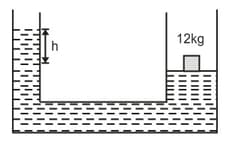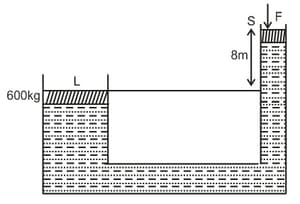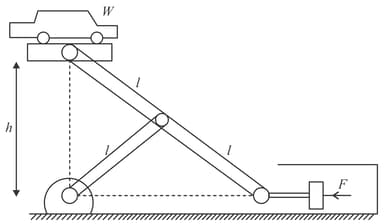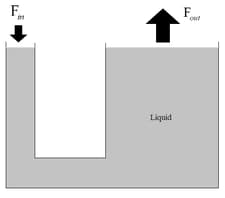Hydraulic Machines
Hydraulic Machines: Overview
This Topic covers sub-topics such as Hydraulic Lift, Mechanical Advantage of Hydraulic Lift and, Braking System of Vehicles
Important Questions on Hydraulic Machines
The area of cross-section of the wider tube shown in figure is . If a mass of is placed on the massless piston, the difference in heights h in the level of water in the two tubes is

For the system shown in the figure, the cylinder on the left athas a mass of and cross-sectional area of . The piston on the right, at , has cross-sectional area and negligible weight. If the apparatus is filled with oil. Find the force required to hold the system in equilibrium

A force of is executed on a hydraulic piston of cross sectional area of . The cross-sectional area of other piston which supports a truck of a tonne weight is [use ]
The working of hydraulic lift is based on the principle of
A car hoist is operated by a hydraulic as pictured. Determine compressive force applied by hydraulic to keep the car-weight in equilibrium at given position.

A hydraulic lift is designed to lift heavy objects of maximum mass . The area of cross section of piston carrying the load is What is the maximum pressure the piston would have to bear?
Which principle works on hydraulic lift?
Write a short note on hydraulic lift.
What is the formula for hydraulic lift?
How braking system in vehicles work?
The mechanical advantage of hydraulic lift is always equal to one.
In a hydraulic lift, the small piston has an area of and the large piston has an area of . What is the mechanical advantage of the hydraulic lift?

Find the mechanical advantage of the hydraulic lift.
Mechanical advantage of a hydraulic lift is directly proportional to the:
In a hydraulic lift, the mechanical advantage is defined as the ratio of the area of cross-section of the piston of output force to the area of cross-section of the piston of the input force. The force on the piston of the smaller area of cross-section is more than that on the piston of the larger area of cross-section.
In a car lift, the mechanical advantage is . If the mass of the car to be lifted by the larger piston is , calculate the force exerted by the compressed air on the smaller piston. Take .
In a hydraulic lift, to increase the mechanical advantage:
What do you understand by the mechanical advantage in a hydraulic lift? Explain in brief.
Hydraulic brakes works on the principle of
The mechanical advantage of a hydraulic lift is directly proportional to
